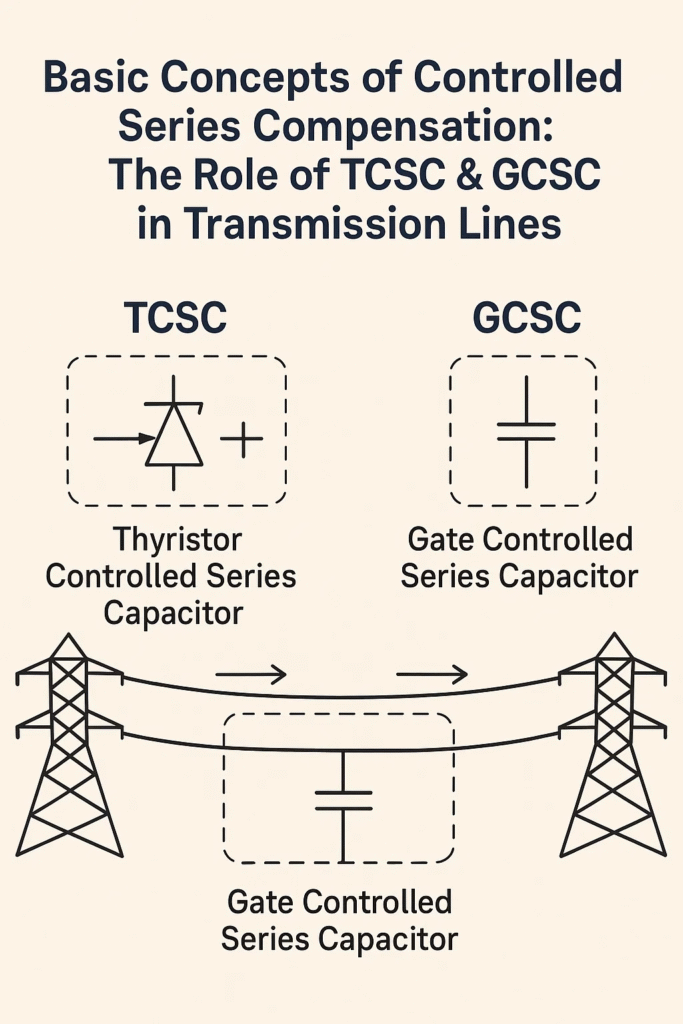Introduction
Modern power transmission systems face increasing challenges: rising demand, integration of renewables, and the need for grid stability. To meet these demands, engineers have turned to Controlled Series Compensation (CSC)—a powerful technique that dynamically adjusts the impedance of transmission lines to optimize power flow and system performance.
Two standout technologies in this domain are the Thyristor-Controlled Series Capacitor (TCSC) and the Gate Turn-Off Thyristor Controlled Series Capacitor (GCSC). These devices are part of the Flexible AC Transmission Systems (FACTS) family and play a crucial role in enhancing grid reliability, efficiency, and flexibility.
Let’s explore how CSC works and the specific roles of TCSC and GCSC in transmission lines.
What Is Controlled Series Compensation (CSC)?
Controlled Series Compensation involves inserting capacitive reactance into transmission lines to reduce their overall impedance. This allows more power to flow through the lines, improves voltage stability, and reduces losses.
Without CSC:
- Transmission lines have high inductive reactance.
- Power transfer is limited.
- Voltage drops and losses increase.
With CSC:
- Capacitors reduce line reactance.
- Power transfer capability increases.
- Voltage profile and system stability improve.
CSC becomes even more powerful when combined with power electronic control, enabling dynamic adjustment of compensation in real time.
Why Series Compensation Matters
Series compensation directly affects the power transfer equation:
P = \frac{V_1 V_2}{X} \sin(\delta)
Where:
- V_1, V_2 are sending and receiving end voltages.
- X is the line reactance.
- \delta is the power angle.
Reducing X increases P, allowing more power to be transmitted over the same infrastructure.
TCSC: Thyristor-Controlled Series Capacitor
Overview
TCSC is a FACTS device that uses thyristors to control the impedance of a series capacitor. It consists of:
- A Fixed Capacitor (FC).
- A Thyristor-Controlled Reactor (TCR) in parallel.
- Control electronics to adjust thyristor firing angles.
Working Principle
By adjusting the firing angle \alpha, the inductive reactance X_L(\alpha) of the TCR changes. This alters the net impedance:
X_{TCSC} = X_C + X_L(\alpha)
The device can operate in: - Blocked Mode: Thyristors off, behaves like a fixed capacitor.
- Bypass Mode: Thyristors fully on, net inductive behavior.
- Vernier Mode: Partial conduction, dynamic impedance control.
Benefits - Real-time power flow control.
- Damping of power oscillations.
- Mitigation of subsynchronous resonance (SSR).
- Enhanced fault recovery.
GCSC: Gate Turn-Off Thyristor Controlled Series Capacitor
Overview
GCSC is similar to TCSC but uses Gate Turn-Off (GTO) thyristors instead of conventional thyristors. This allows for:
- Faster switching.
- Lower losses.
- Improved harmonic performance.
Working Principle
GCSC modulates the series capacitance by turning GTO thyristors on and off. Unlike TCSC, which uses firing angle control, GCSC uses gate signals to directly control conduction.
Benefits - High-speed response.
- Reduced harmonic distortion.
- Better efficiency in high-voltage applications.
TCSC vs GCSC: A Comparison
| Feature | TCSC | GCSC |
| Switching Device | Conventional Thyristor | GTO Thyristor |
| Control Method | Firing Angle | Gate Signal |
| Response Time | Moderate | Fast |
| Harmonics | Higher | Lower |
| Efficiency | Good | Better |
| Complexity | Moderate | High |
Dynamic Impedance Control
Both TCSC and GCSC provide dynamic impedance control, which is essential for:
- Voltage Regulation: Maintaining stable voltage under varying loads.
- Power Flow Optimization: Redirecting power to avoid congestion.
- Stability Enhancement: Damping oscillations and improving transient response.
This control is achieved through feedback systems that monitor line conditions and adjust compensation accordingly.
Applications in Transmission Networks
- Long-Distance Transmission
- Reduces losses.
- Enhances voltage stability.
2. Renewable Energy Integration
- Stabilizes output from wind and solar farms.
- Manages variability.
3. Urban Grids
- Prevents overloads.
- Improves reliability.
4. Industrial Systems
- Reduces voltage sags.
- Supports heavy machinery.

Impact on Power System Performance
| Parameter | Without CSC | With TCSC/GCSC |
| Power Transfer | Limited | Enhanced |
| Voltage Stability | Poor | Improved |
| Oscillation Damping | Minimal | Strong |
| SSR Risk | High | Mitigated |
| Fault Recovery | Slow | Fast |
Challenges and Considerations
While TCSC and GCSC offer significant benefits, they come with challenges:
- Cost: High initial investment.
- Complexity: Requires advanced control systems.
- Maintenance: Sensitive components need regular checks.
- Harmonics: Especially in TCSC, require filtering.
Future Trends
The future of CSC technologies is promising:
- AI-Based Control: Predictive algorithms for smarter compensation.
- Hybrid Devices: Combining TCSC/GCSC with STATCOM or SVC.
- Advanced Semiconductors: Faster, more efficient switching.
Conclusion
Controlled Series Compensation (CSC) is a cornerstone of modern power transmission. By dynamically adjusting line impedance, it enables efficient, stable, and flexible power delivery.
TCSC and GCSC are two powerful tools in this domain. While TCSC offers robust control through thyristor firing, GCSC pushes the envelope with faster, cleaner switching via GTOs.
Together, they empower transmission networks to meet the demands of the future—smart grids, renewable integration, and resilient infrastructure.
